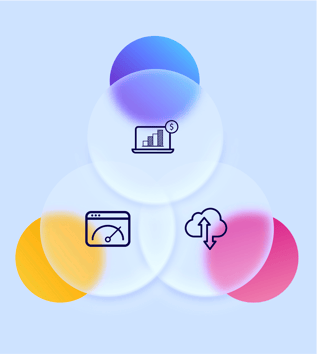As the app industry grows, consumer preferences change, and business strategies evolve, monetization teams must adapt to keep up. It may be easier to plan for what you know — to plan for the present — but in such a fast-changing business ecosystem, that can leave you over and under-invested in all the wrong places.
So how can app publishers future-proof their monetization teams and strategies?
 That's the question asked in a recent webinar put together by Gamesforum and oolo. The webinar featured a panel of experts from ZeptoLab, Tripledot Studios, Popcore, and oolo.
That's the question asked in a recent webinar put together by Gamesforum and oolo. The webinar featured a panel of experts from ZeptoLab, Tripledot Studios, Popcore, and oolo.
And while none of these panelists claim any psychic abilities, there was a lot of agreement about what the future holds.
The group agreed that, with time, the increasing embrace of in-app bidding over traditional waterfalls will push monetization teams to take on a much wider, more full-stack purview. They also agreed that, despite those widening responsibilities, monetization professionals will still be expected to deliver the same level of down to the fine-details oversight that's expected of them today.
Listening to these experts predict the future, you quickly realize that it's not a matter of reading tea leaves but looking at the data.
Planning for App Bidding, Living with Waterfalls
In the past, the role of monetization manager was mostly about making sure things don't break and optimizing waterfalls. In the future, it'll mean working closely with product to balance IAP and IAA interests with each other, within the core loop, and within the app economy.
It'll also mean eliminating blindspots and asserting as much control as possible over all aspects of monetization; even over those things that seem less controllable — like bidding.
As we move toward in-app bidding, it's important to note that the march is steady, but not super fast. Bidding hasn't totally taken over yet and isn't likely to do so anytime soon. According to Jane, the Director of Monetization at Popcore, about 50% of revenue today comes from bidding — while the rest still coming from traditional waterfalls. So the old way of doing things is far from extinct.
Because of this, the best course of action is to take a hybrid approach — adding bidding slowly without giving up on or ignoring your waterfalls.
App Bidding: More Than Meets the Eye
The core concept behind app bidding is very simple: let everything compete directly so that there's no economic deadweight or organizational hassle.
In theory, that should leave nothing to optimize — which would immediately remove a huge chunk of tasks from the monetization team. but when it comes to implementation, in-app bidding quickly becomes extraordinarily complex. And it's in that complexity that the reality of the matter strays from the core concept.
Not As Advertised
For example, when app bidding is set up to operate head-to-head with manually managed waterfall placements, bidding doesn’t always outperform. More interesting, even when bidding does win, it consistently performs better when running alongside a traditional waterfall setup.
This doesn't comport with the way that app bidding is supposed to work, but it does reflect the messy reality of the situation. That messiness has a lot to do with why the transition to bidding will take a good amount of time.
Not Always Available
Of course, even if app bidding worked exactly as advertised, at this stage it's still not offered by some of the major networks.
When in-app bidding becomes newly available in a given network, decision makers should resist the urge to switch everything over all at once. Instead, it's best to test and temper your setup. We still don't really know a lot about how bidding works in practice and by all indications, the networks themselves are still trying the figure it out.
We don't know how app bidding might be implemented for network A and we don't know how that differs from network B. But we can be pretty sure that the different networks are going about it differently, as we see very different results across networks.
Getting the Most Out of App Bidding
The fact is we're dealing with something of a black box and that's why it’s so important that you run your own experiments to learn the ins and outs of the matter.
-min%20(1).png?width=1500&name=Picture1-min%20(1)-min%20(1).png)
Despite its promise, app bidding cannot be treated as a set it and forget it solution. As a best practice, monetization managers should assume that their inventory will in fact not be filled in a way that maximizes revenue unless they apply a firm guiding hand.
But what does that mean for bidding where all the controls of a waterfall setup seem to be missing?
Some platforms allow for geo-based price floors. This can be an important means of control for certain formats (i.e. rewarded video) and specific edge cases that encroach on margins and risk throwing off overall performance. But it's more than that. Often, we're not entirely aware of all the available controls or indirect instruments of influence over placements. That's why it's important to work closely with your networks representatives.
Be The Squeaky Wheel
Despite the clean and pristine frontend veneer, whenever you're dealing with technology — especially new technology — things sometimes break. For example, we at oolo still see bidding spikes associated with specific OS versions, app versions, or SDK versions. When these things happen, the networks often have ways of addressing the issue. If you can get them to take action in such a case, you’ll usually see a pretty quick recovery on your end.
The squeaky wheel gets the grease and applying pressure on the commercial side can really help to make sure that value is being delivered according to expectations.
It’s important that you let the network know you’re on top of what’s going on and that you expect things to work as advertised. Even when there’s nothing's really broken, there are typically things that can be played with on the network side to augment performance.
It's important that you test things for yourself and reach out to your account manager early & often:
- Asking a lot of questions
- Pushing back on answers given
- Requesting clarifications
- Agitating for improved outcomes
Work the Quirk
Because there's still so much uncertainty in how app bidding works and because many of the underlying mechanics remain in flux, there's an opportunity for crafty Monetization Managers to get a leg up. Exploration is the means while exploitation is the motive. You should be looking for any unseen pressure points you can bear down on.
One great example of this is the fact that, according to the webinar panelists, using bidding together with manual waterfalls consistently produces better results.
There’s no one-size-fits-all answer and that's why it’s really important that app publishers experiment and test as much as possible to find out what works best. Even when you find what works best for one app, it won’t necessarily hold true for another app. Everything needs to be tested at each level and with an understanding of the relevant contextual intricacies (app genre, ad format, etc.)
Move the Market
 Of course, in-app bidding is a product and like any other product the exact shape it takes will be determined by the push and pull of the marketplace. If the demand side of the market pushes for more control at different strategic levels (like cohort, payer, non-payer, etc.), the supply side will have to respond. So far that hasn't really happened, but it surely will.
Of course, in-app bidding is a product and like any other product the exact shape it takes will be determined by the push and pull of the marketplace. If the demand side of the market pushes for more control at different strategic levels (like cohort, payer, non-payer, etc.), the supply side will have to respond. So far that hasn't really happened, but it surely will.
Even as small publishers are happy to surrender some control to level the playing field, for more mature, more sophisticated, and better resourced organizations, it's a lost opportunity.
And with those bigger publishers wielding greater market influence, you can be sure they'll ask for more complex tools to assert more control (to dynamically exclude bidders, change floor prices, season triggers, etc.).
Conclusion
While the industry is looking forward to the time that app bidding replaces waterfalls, that time is still a ways away. The promise of automation means less tedious tinkering and more strategic planning.
At the same time, manual processes do sometimes have their advantages — if for nothing else than the extra control and transparency. Which is why the future will be won by teams and technologies that are able streamline workflows, accelerate outcomes, and reduce frictions while still maintaining control & transparency. It's true of app bidding in particular and it's true of monetization and growth tasks in general.
Following the adoption of bidding, more levers of control will be needed — and ultimately developed. Part of this demand will be met by third-party solution providers, but publishers will still need to do their part. They will need to band together to apply pressure directly on the networks. And they'll need to place renewed internal emphasis on cross-departmental collaboration, streamlined strategy, and a shared data perspective.
As the focus shifts more to planning, integration, automation, and oversight, best in class publishers will find new ways to remove unnecessary tasks and help their managers better focus on growth. And that's something I think we're all very much looking forward to!








